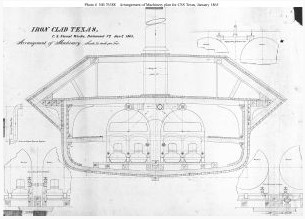
The CSS Texas
USinfo | 2012-11-27 14:37
The CSS Texas (Confederate States Ship Texas), was a shallow draft, twin screw, casement ironclad ram of the Confederate Navy, named for the state of Texas. She was sister ship to CSS Columbia. Since the ironclad was built so late in the American Civil War, she saw no action before being captured by Union forces while still in her outfitting berth
One of the few pictures of CSS Texas in existence; a cross-section drawing through the boiler area.
History
The keel for the CSS Texas was laid down at Richmond, Virginia. She was launched in January 1865. At the time of Robert E. Lee's evacuation of Richmond on 3 April 1865, she was left unfinished but intact at the Richmond Navy Yard, one of only two vessels which escaped destruction by the retreating Confederate forces. Captured when the city fell the following day, the ironclad was taken into the United States Navy, but saw no active service. Texas was laid up at Norfolk until 15 October 1867 when she was sold at auction for eventual scrapping to J. N. Leonard & Co. [1] of New Haven, Connecticut.
Design
From a technological view, the CSS Texas was one of the three "Tennessee class" ironclads (the other two being the CSS Tennessee II and the CSS Columbia) that used the latest in Confederate shipbuilding efforts.
The casemate of the Texas was octagonal, rather than being a sloped, rectangular box as on the earlier Confederate ironclads. The casemate fitted snugly around her forward, broadside, and aft cannon positions. Instead of being bolted to the deck, the pilot house formed a seamless extension of her sloped side-armor.
Details of her armament remain sketchy, but her sister ship, the CSS Tennessee II carried four 6.4 inch Brooke rifles, two 7.0 inch Brooke rifles, and a bolted-on spar torpedo. The armor of the CSS Tennessee II was listed as three layers, two inches thick, apiece. Her top speed was about five knots, according to some sources, and her crew was about 133 sailors. However, it is unclear how closely the Texas was to resemble the Tennessee II.
Other sources gave the Texas a (projected) top speed about 10 knots, and these note that both the Tennessee II and the Texas differed from each other in their plans due to a lack of available key metals, in particular for their cannons and engines, and also in design improvements made during her construction from lessons that had been learned in combat with the U.S. Navy.
A plan of a gun and mounting intended for installation on the ironclad CSS Texas.
CSS Texas in fiction
In some editions of the novel Sahara (pub. 1992) by the adventure writer Clive Cussler, President Abraham Lincoln is kidnapped by a group of soldiers who impersonated a Union cavalry detachment. They overpowered Lincoln's military escort in early April 1865 as the Civil War was drawing to a close. Edwin Stanton, the Secretary of War, took the lead in arranging a cover-up supposedly posing John Wilkes Booth as a patriot who quickly brought the situation to an abrupt conclusion–supported by Stanton—and then destroying documentation and concealing the accused conspirators under heavy hoods so no one really knew who they were, but of importance here is that the real Lincoln was supposedly spirited out of the country on the CSS Texas.
Casting off at night after loading Confederate gold and government files, the ship steamed downstream in the dark, but then she got caught in a running gun battle with Union ships and suffered from some damage.
The Texas avoided a pounding and a probable sinking by Union batteries at the mouth of the river when her captain of the boat raised a white flag. He displayed Lincoln on top of the pilot house as the warship escaped into a fog bank.
The story resumes in modern times with the CSS Texas being discovered in the sand of the Sahara Desert. She had become grounded in a branch of the Niger River. On board were the bodies of fifty men plus the remains of the ship's captain and Lincoln, all of which had been preserved in the dry desert heat.
After running the warship aground, her crew had to trade the gold with the Africans for food. Having realized that there was gold on board, they blockaded the boat, starving to death all but one member of her crew.
The single surviving man, out of four who started in his group, escaped in a small boat and then he was rescued by English traders.
In the 2005 feature film Sahara based on Cussler's novel, the CSS Texas figures more actively in the action sequences.
Share this page




















